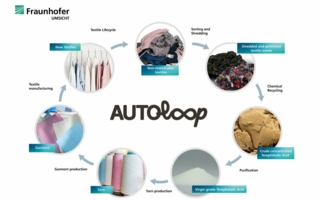13/12/2024 – Research project — auf Deutsch lesen
3D-printing on pre-stretched textiles
3D-printing on pre-stressed textiles is a current focus of research at Sächsisches Textilforschungsinstitut e. V. (STFI), which is generating numerous new application possibilities.
The cooperation project between the STFI and Modellbau Clauß GmbH & Co. KG (MBC), Neukirchen/Erzgebirge, focuses on machine and process development for 3D printing on pre-stretched textiles with subsequent shape change effects. MBC’s objective was to develop a size-adjustable multi-axis tensioning frame for the defined stretching of elastic textiles. In collaboration with the STFI, various clamping elements for fixing the textile substrates were tested. The initial focus was on stretchable polyester and polyamide knitted fabrics.
A suitable clamping system was selected based on tensile tests carried out. After successful production and assembly, the multi-axis tensioning system was set up at the STFI for extensive testing. With the help of the developed system, textiles can be tensioned with precisely adjustable forces in the longitudinal and transverse directions. The tensioned textiles can then be removed in two different sizes, either 50x50 cm or 32.8x24.8 cm, and then functionalised using 3D printing.
STFI’s objective was to develop the technology for partially stiffening 3D printing on pre-stretched textiles with subsequent shape change effects. For this purpose, various thermoplastic printing materials were initially tested for stiffness and hardness as well as for their adhesion to the textile substrates.
The printing parameters were adjusted accordingly as part of extensive series of tests with defined elongation states of the textile substrates in the longitudinal and transverse directions. It was especially important to determine the possibilities for defined stretching of the textiles in order to obtain reproducible results and to be able to predict the deformation effects. Following, various demonstration samples were developed to show which products can be manufactured using this technology. These included various lamp designs and acoustic panels. With the help of machine and process development for 3D printing on pre-stretched textiles, the individual resource-efficient production of these demonstration samples was demonstrated.
The next step will be to further optimise the technology. The focus will be on testing other textile materials to expand potential fields of application.





